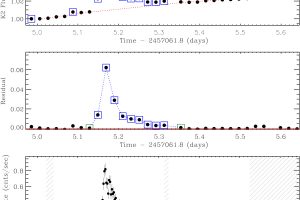Super-flares in the Pleiades. The study: “Simultaneous Kepler/K2 and XMM-Newton observations of superflares in the Pleiades” of M. G. Guarcello (INAF-OAPA) recently appeared on A&A

Observations of the Sun show that our star hosts transient and violent phenomena which are due to the interaction between the plasma and the magnetic field produced in the interior of the Sun. Typical examples of this “magnetic activity” are the sunspots in the photosphere and the protuberances in the chromosphere. The solar flares are among those phenomena associated with the largest release of energy.
Solar flares are triggered by a rapid release of energy by the magnetic field in the solar corona after a rearrangement of its topology, which causes a sequence of phenomena occurring in the corona, chromosphere, and photosphere. The released energy, in fact, accelerates particles up to MeV energy. These particles move along the magnetic field lines impacting the plasma in the photosphere. They then release part of their energy, heating the surrounding plasma up to few million degrees (against the typical temperatur ein the photosphere of about 5700 degrees). The heated plasma evaporates because of its larger pressure, filling the magnetic loops above, and creating the spectacular coronal loops which are typically observed in X-rays, where the plasma reaches even more than 10 million degrees. The solar flares release between 1031 e 1032 erg of energy, which is about 1/10 to 1/100 of the total energy released by the Sun in one second (whose total luminosity is 4×1033 erg/sec).
Flares are observed also in other stars. In particular, young stars are characterized by a more intense magnetic activity because of their typically faster rotation (which is connected to the production of the magnetic field), which produces more frequent and more energetic flares than the Sun. Pre-main sequence stars, for instance, can host flares releasing up to 1036 erg only in the X-ray band. Flares releasing more than 1034 erg are typically called “superflares”, and their study is important, for instance, for the impact the may have on the surrounding environment. For instance, superflares occurring in the Sun could ionize the ozone in our atmosphere, with serious consequences on our planet.
The study: “Simultaneous Kepler/K2 and XMM-Newton observations of superflares in the Pleiades“, of M. G. Guarcello, recently appeared on Astronomy & Astrophysics, is based on one of the rare simultaneous observations in optical (from Kepler satellite, in the framework of the K2 mission) and X-rays (from XMM/Newton) of superflares occurred in other stars, in this case the Pleiades, which is the closest stellar cluster to the Sun, with an age of 125 million years. The authors have measured the energy released by the observed superflares and their duration in the two bands, and then they compared the properties of the optical flares (occurred in the photosphere) with those of the simultaneous X-ray flares (occurred in the coronal loops). This comparison is important to understand the connection between the phenomena occurring in photosphere and corona during a superflare, and to understand how the magnetic activity in young and active stars can be compared with that of the Sun.
The figure (link) shows one of the superflares observed in the Pleiades. The upper panel show the optical flare observed by Kepler/K2. The central panel show the same flare but with the quiescent emission removed. The bottom panel shows the same flare observed in X-rays.
